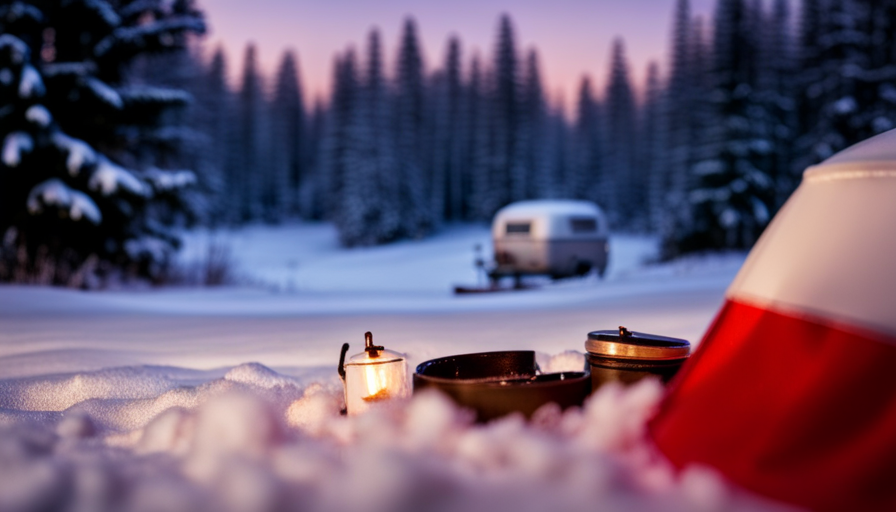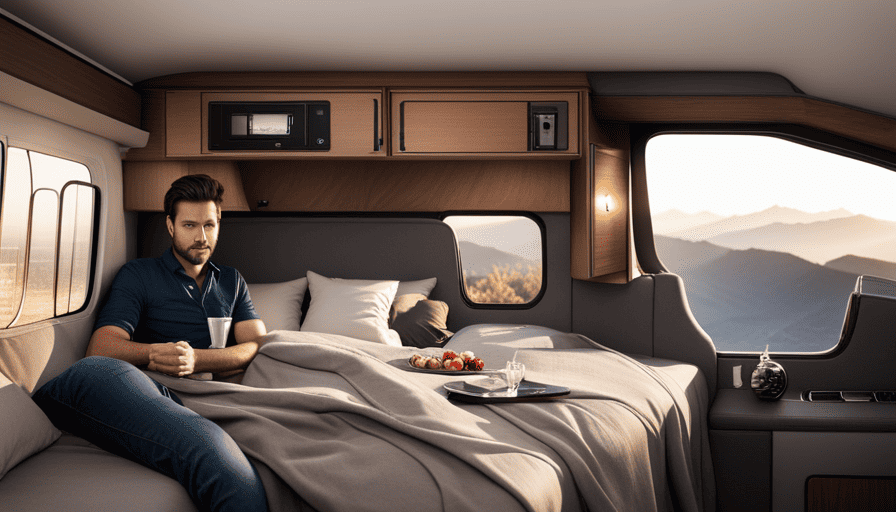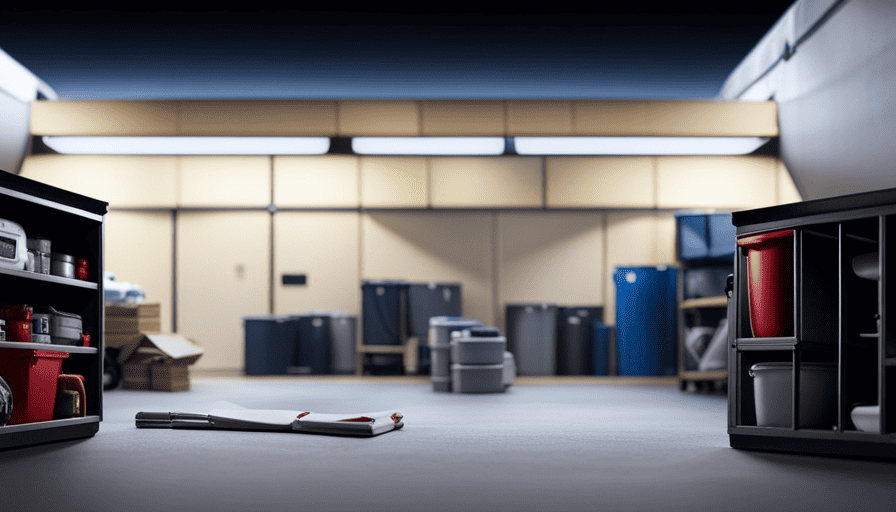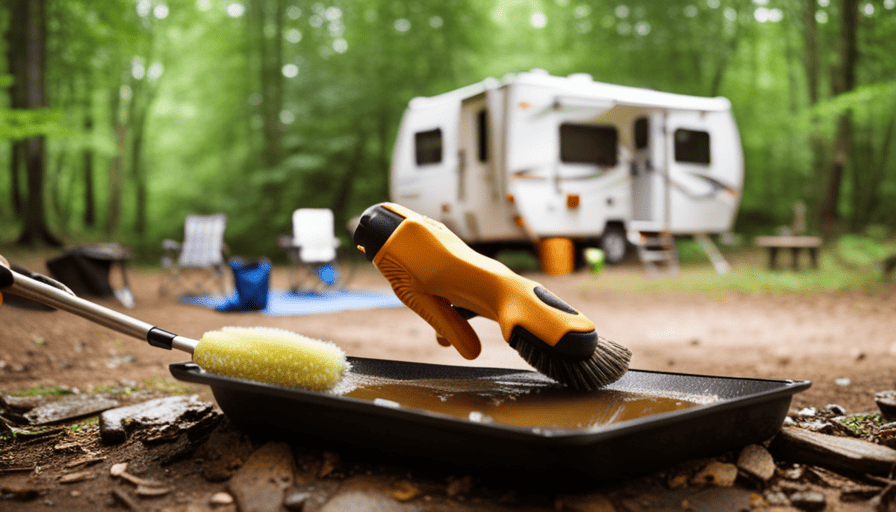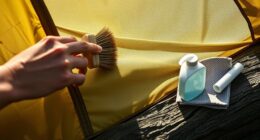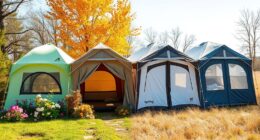As the chilly winter season comes to an end, we are filled with anticipation for the upcoming adventures. It’s time to dust off our camping gear and embark on thrilling journeys into the great outdoors. But before we can hit the road, there’s a crucial task we need to take care of – getting our beloved camper ready for use after the winter.
This process, though seemingly daunting, is essential to ensure a smooth and enjoyable camping experience. By following a few simple steps, we can revive our camper from its hibernation and prepare it for the upcoming season. From flushing the plumbing system to testing the electrical components, we’ll guide you through each meticulous detail, ensuring that your camper is in optimal condition.
So grab your tools, roll up your sleeves, and let’s dive into the technical intricacies of unwinterizing your camper, because adventure awaits!
Key Takeaways
- Gather necessary tools and supplies for the unwinterizing process, such as adjustable wrenches, a water pressure regulator, a water hose, and a water pump converter kit.
- Take safety precautions, including turning off the water supply and disconnecting electrical sources before starting the unwinterizing process.
- Flush the plumbing system thoroughly to remove any antifreeze and winterizing agents that were used during the winterization process.
- Inspect and test various components, such as the water heater, electrical connections, propane system, and tires, to ensure they are functioning correctly and free from any damage or leaks.
Gather Your Tools and Supplies
Now it’s time to gather all our tools and supplies, so we can easily see them laid out in front of us and get ready to start unwinterizing our camper. Before we begin, it’s important to take some essential safety precautions. Make sure to wear protective gloves and eyewear to avoid any accidents. Additionally, turn off the main water supply and disconnect the camper from any electrical sources to prevent any mishaps.
To ensure an efficient unwinterizing process, it’s helpful to have a few key tools and supplies. We’ll need a set of adjustable wrenches to remove any fittings and drain plugs. A water pressure regulator is also essential to prevent any damage to the plumbing system. It’s recommended to have a water hose specifically designated for the camper to avoid contamination. Don’t forget to have a water pump converter kit handy, as it’ll come in handy when connecting the camper to a water source.
With all our tools and supplies gathered, we can now move on to flushing the plumbing system. This step will ensure that any antifreeze or winterizing agents are completely removed, allowing us to use the water system without any issues.
Flush the Plumbing System
To get your water flowing again, start by flushing out the plumbing system using a small amount of bleach to kill any bacteria that may have built up over the winter months. Did you know that, according to a survey, 86% of campers experience some sort of plumbing issue when first unwinterizing their RVs?
Common plumbing issues include frozen pipes, clogged drains, leaky fittings, and water pressure problems.
Tips for maintaining a camper’s plumbing system:
- Insulate exposed pipes to prevent freezing.
- Use drain strainers to catch debris and prevent clogs.
- Regularly inspect fittings for signs of wear and replace as needed.
- Flush the system with fresh water before and after each camping season to remove any residual antifreeze or sediment.
Now that you have flushed the plumbing system, it’s time to check the water heater and ensure it’s in proper working condition.
Check the Water Heater
Make sure you take a moment and check your water heater to ensure it’s working properly and ready to provide you with a warm and comforting shower experience. Water heater maintenance is crucial after winter storage.
Start by inspecting the exterior of the water heater for any signs of damage or corrosion. Look for leaks around the connections and fittings. If you notice any issues, it’s important to address them before using the water heater.
Next, check the pressure relief valve. This valve is designed to release excess pressure and prevent the tank from bursting. Lift the lever on the valve and let some water flow out. If the valve doesn’t release water or if it continues to leak after releasing, it may need to be replaced.
Now, troubleshoot any water heater issues. Turn on the hot water faucet and check if the water gets hot. If it doesn’t, check the pilot light. If it’s out, relight it according to the manufacturer’s instructions. If the pilot light is on but the water still doesn’t get hot, you may need to clean or replace the burner assembly.
Checking the water heater is an essential step in unwinterizing your camper. Once you’ve ensured that the water heater is in good working condition, you can move on to inspecting the electrical components.
Inspect the Electrical Components
Don’t forget to check the electrical components to ensure they’re functioning properly and ready to provide you with power during your camping adventures.
One important thing to inspect is the battery connections. Start by examining the battery terminals for any signs of corrosion or loose connections. If you notice any corrosion, clean it off using a mixture of baking soda and water, and then rinse it thoroughly. Tighten any loose connections using a wrench, making sure they’re secure.
After checking the battery connections, it’s time to test the circuit breakers. Locate the circuit breaker panel, usually found in the camper’s electrical compartment. Open the panel and inspect each breaker for any signs of damage or tripped switches. Reset any tripped breakers by flipping them off and then on again. If you notice any damaged breakers, they should be replaced before using the camper.
Once you’ve inspected the battery connections and tested the circuit breakers, you can move on to the next section about testing the propane system. It’s important to ensure that all the electrical components are in good working condition before moving forward.
Test the Propane System
Ensure your camping adventures are safe and worry-free by testing the propane system and guaranteeing its functionality. Propane safety is of utmost importance when it comes to RV camping, so it’s crucial to inspect the system before hitting the road.
To begin, check the propane tank for any signs of damage or leaks. Use a mixture of soap and water to create a solution, and apply it to the connections and valves. If you notice bubbles forming, it indicates a leak, and immediate action should be taken.
Next, inspect the propane lines for any signs of wear or damage. Look for cracks, holes, or loose connections. If you come across any issues, it’s best to consult a professional for repairs or replacements.
Additionally, make sure the propane regulator is functioning properly. It regulates the pressure and ensures a steady flow of propane to the appliances. If you notice any irregularities, such as low flames or difficulty lighting the stove, it could indicate a problem with the regulator.
Troubleshooting tips for the propane system include checking the propane detectors and alarms. These devices are essential for alerting you to any gas leaks, so make sure they’re in working order.
Lastly, ensure all propane appliances are tested and functioning correctly. This includes the stove, oven, refrigerator, and water heater.
Now that the propane system has been thoroughly inspected and tested, we can move on to the next section about checking the tires and brakes.
Check the Tires and Brakes
Inspecting the tires and brakes is crucial for a smooth and safe RV camping experience, ensuring optimal performance on the road. Here are three important steps to consider for tire maintenance and brake inspection:
-
Check tire pressure: Start by inspecting the tire pressure using a reliable pressure gauge. Ensure that the pressure matches the manufacturer’s recommendations for your specific camper model. Underinflated tires can lead to poor fuel efficiency and increased risk of blowouts, while overinflated tires can result in a harsher ride and reduced traction.
-
Examine tire tread: Inspect the tread depth on all tires to ensure they meet the minimum requirement. A worn-out tread can compromise traction, especially on wet or slippery surfaces. Consider using a tread depth gauge to accurately measure the depth and replace any tires that fall below the recommended limit.
-
Test the brakes: Perform a thorough brake inspection to ensure they’re functioning properly. Start by checking the brake pads for wear and tear. If they’re too thin, they should be replaced. Additionally, inspect the brake lines for any signs of damage or leaks. Lastly, test the brakes by applying them gently while driving at a low speed. Listen for any unusual noises or vibrations, and if any issues are detected, have them repaired by a professional.
By following these tire maintenance and brake inspection steps, you can ensure a safe and hassle-free camping experience.
Transitioning into the subsequent section about cleaning the interior and exterior, it’s important to maintain a clean and well-maintained camper for a comfortable trip.
Clean the Interior and Exterior
Make your RV camping experience even more enjoyable by giving both the interior and exterior a thorough cleaning.
When it comes to cleaning the interior of your camper, deep cleaning is essential to remove any dirt and grime that may have accumulated during the winter months. Start by vacuuming and mopping the floors, wiping down all surfaces with a mild cleaner, and cleaning the windows to let in the natural light. Don’t forget to clean the bathroom thoroughly, including the toilet, shower, and sink. Pay attention to any upholstery or curtains that may need freshening up by spot cleaning or laundering.
For the exterior maintenance, start by washing the exterior with a gentle soap and water solution, using a soft brush or sponge to remove any dirt or debris. Pay special attention to the roof and awning, as these areas can collect a lot of dirt. Inspect the exterior for any damage, such as cracks or leaks, and make any necessary repairs.
Once you have finished cleaning the interior and exterior, it’s time to restock and organize your supplies for the upcoming camping season.
Restock and Organize Supplies
After giving your RV a thorough cleaning, it’s time to restock and get organized for the upcoming camping season. Here are a few steps to help you efficiently restock food and organize your camping gear:
-
Restocking food: Take inventory of your pantry and refrigerator to determine what needs to be replenished. Make a shopping list and purchase non-perishable items in bulk to save money and ensure you have enough supplies for your camping trips. Consider easy-to-cook meals and snacks that can be stored for longer periods. Don’t forget to include essential condiments and spices.
-
Organizing camping gear: Start by sorting through your camping gear and removing any items that are damaged or no longer useful. Clean and dry your gear before storing it. Utilize storage compartments, bins, or shelves to keep everything organized. Categorize items such as cooking utensils, sleeping gear, and outdoor equipment to make them easily accessible. Labeling containers can also help you quickly locate what you need.
Now that you have restocked your food and organized your camping gear, it’s time to move on to the next step: testing the appliances. Ensure that all appliances are in proper working condition before your next camping adventure.
Test the Appliances
Now it’s time to check if all the appliances are in proper working condition before your next camping adventure. When testing the appliances in your camper, it’s important to take safety precautions to ensure your well-being.
Make sure the camper is properly ventilated to avoid any build-up of harmful gases. Additionally, disconnect the power source and turn off any propane gas before conducting any tests.
When testing the appliances, there are a few common issues to look out for. For the refrigerator, check if it’s cooling properly and if the freezer is maintaining a low temperature. Ensure that the stove burners are igniting correctly and that the oven is heating up evenly. Test the water heater to see if it’s providing hot water consistently. Don’t forget to check the air conditioner and the furnace for any unusual noises or malfunctions.
By thoroughly testing the appliances, you can identify any issues before hitting the road. This will allow you to plan your next camping adventure with peace of mind, knowing that you won’t encounter any unexpected problems.
So, let’s move on to the next section and start planning our exciting trip!
Plan Your Next Camping Adventure
Let’s start brainstorming and organizing all the details for your upcoming camping adventure!
Choosing the best camping location is crucial for a successful trip. Consider factors such as proximity to nature trails, availability of water sources, and the overall terrain. Research different campgrounds and read reviews to ensure the location meets your needs.
Once you’ve chosen a location, it’s essential to prioritize safety. Begin by packing a well-stocked first aid kit, including items like bandages, antiseptic wipes, and pain relievers. Familiarize yourself with any potential hazards in the area, such as poisonous plants or wildlife, and take necessary precautions.
In addition to safety, it’s crucial to plan for comfort. Make a checklist of essential camping gear, such as a tent, sleeping bags, and cooking equipment. Don’t forget to pack extra layers of clothing and appropriate footwear for varying weather conditions.
To enhance your camping experience, consider engaging in outdoor activities like hiking, fishing, or bird-watching. Research local attractions and plan accordingly. Additionally, don’t forget to check if you need any permits for specific activities, such as fishing licenses or campfire permits.
By carefully selecting the best camping location and incorporating essential safety tips, you can ensure a memorable and enjoyable camping adventure. So gather your gear, plan your itinerary, and get ready for an incredible outdoor experience!
Frequently Asked Questions
How do I winterize a camper?
To winterize a camper, we use various techniques to ensure proper maintenance. First, drain all water tanks and lines to prevent freezing and damage.
Next, add RV antifreeze to the plumbing system to protect against freezing temperatures. Don’t forget to disconnect the battery and store it in a cool, dry place.
Finally, cover the camper with a waterproof cover to shield it from the harsh winter elements. Following these steps will help preserve your camper during the winter season.
How often should I winterize my camper?
To properly maintain your camper, it’s recommended to winterize it annually, before the cold weather hits. This will protect your camper from potential damage caused by freezing temperatures.
The best time to winterize is before the first freeze, usually in late fall. By winterizing your camper regularly, you can prevent costly repairs and ensure its longevity.
Remember to drain the water system, add antifreeze, and protect all exposed areas to safeguard your camper during the winter months.
Can I use regular antifreeze to winterize my camper?
Using regular antifreeze to winterize a camper can be risky. While it may seem convenient and cost-effective, regular antifreeze is not designed for RV plumbing systems. It can damage seals, rubber components, and water lines. It’s important to use antifreeze specifically formulated for RVs. It contains additives to protect the plumbing system. Using alternative antifreeze options, such as non-toxic RV antifreeze, is a safer choice to protect your camper during winterization.
What should I do if I find any leaks in the plumbing system?
If we find any leaks in the plumbing system, we need to take immediate action to prevent water damage and fix the issue. First, we should turn off the water supply to the camper.
Then, we can inspect the pipes and connections for any visible leaks. If we spot a leak, we can use plumber’s tape or sealant to repair it.
It’s important to address these leaks promptly to avoid further damage to the camper’s interior.
How can I ensure the electrical components are functioning properly?
To ensure the electrical components of your camper are functioning properly, we must first investigate the truth of a theory. Checking electrical connections is crucial. Start by inspecting all wiring and connections for any signs of damage or corrosion.
Next, testing circuit breakers is essential. Use a multimeter to measure the voltage across each breaker and ensure they’re not tripped.
These steps will help ensure the electrical system of your camper is in good working order.
Can I Unwinterize my Camper and Convert the Dinette into a Bed at the Same Time?
Yes, you can unwinterize your camper and convert the dinette into a bed at the same time. Turning camper dinette into bed is a great way to maximize space and create a more comfortable sleeping area. Just make sure to follow the proper steps for unwinterizing your camper before transforming the dinette.
Conclusion
As we wrap up the process of unwinterizing our camper, we can feel a sense of accomplishment and excitement. With our trusty tools and supplies in hand, we’ve successfully flushed the plumbing system, checked the water heater, inspected the electrical components, tested the propane system, and cleaned both the interior and exterior.
Our supplies are restocked and organized, ready for our next adventure. As we test the appliances, we can almost taste the anticipation of our upcoming camping trip. The journey begins anew, and we’re ready to hit the road with our unwinterized camper in tow. Let the adventures begin!


